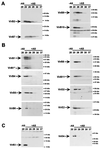Elevated temperature differentially affects virulence, VirB protein accumulation, and T-pilus formation in different Agrobacterium tumefaciens and Agrobacterium vitis strains
- PMID: 11698374
- PMCID: PMC95526
- DOI: 10.1128/JB.183.23.6852-6861.2001
Elevated temperature differentially affects virulence, VirB protein accumulation, and T-pilus formation in different Agrobacterium tumefaciens and Agrobacterium vitis strains
Abstract
That gene transfer to plant cells is a temperature-sensitive process has been known for more than 50 years. Previous work indicated that this sensitivity results from the inability to assemble a functional T pilus required for T-DNA and protein transfer to recipient cells. The studies reported here extend these observations and more clearly define the molecular basis of this assembly and transfer defect. T-pilus assembly and virulence protein accumulation were monitored in Agrobacterium tumefaciens strain C58 at different temperatures ranging from 20 degrees C to growth-inhibitory 37 degrees C. Incubation at 28 degrees C but not at 26 degrees C strongly inhibited extracellular assembly of the major T-pilus component VirB2 as well as of pilus-associated protein VirB5, and the highest amounts of T pili were detected at 20 degrees C. Analysis of temperature effects on the cell-bound virulence machinery revealed three classes of virulence proteins. Whereas class I proteins (VirB2, VirB7, VirB9, and VirB10) were readily detected at 28 degrees C, class II proteins (VirB1, VirB4, VirB5, VirB6, VirB8, VirB11, VirD2, and VirE2) were only detected after cell growth below 26 degrees C. Significant levels of class III proteins (VirB3 and VirD4) were only detected at 20 degrees C and not at higher temperatures. Shift of virulence-induced agrobacteria from 20 to 28 or 37 degrees C had no immediate effect on cell-bound T pili or on stability of most virulence proteins. However, the temperature shift caused a rapid decrease in the amount of cell-bound VirB3 and VirD4, and VirB4 and VirB11 levels decreased next. To assess whether destabilization of virulence proteins constitutes a general phenomenon, levels of virulence proteins and of extracellular T pili were monitored in different A. tumefaciens and Agrobacterium vitis strains grown at 20 and 28 degrees C. Levels of many virulence proteins were strongly reduced at 28 degrees C compared to 20 degrees C, and T-pilus assembly did not occur in all strains except "temperature-resistant" Ach5 and Chry5. Virulence protein levels correlated well with bacterial virulence at elevated temperature, suggesting that degradation of a limited set of virulence proteins accounts for the temperature sensitivity of gene transfer to plants.
Figures







References
Publication types
MeSH terms
Substances
LinkOut - more resources
Full Text Sources

